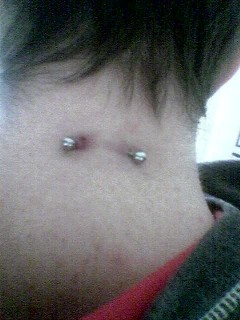 Nape piercings, informally called Neck piercings, are very new to mainstream culture. While it has been accepted for some time in body modification circles, people not stereotypically into bod-mod are getting their napes pierced. It is a great piercing for many people, because it can be exposed or covered according to a specific occasion with great ease.
Nape piercings, informally called Neck piercings, are very new to mainstream culture. While it has been accepted for some time in body modification circles, people not stereotypically into bod-mod are getting their napes pierced. It is a great piercing for many people, because it can be exposed or covered according to a specific occasion with great ease.This ability to hide or display the piercing is quite an attractive "selling point" to people, and when done correctly, this piercing can look fantastic. Nape piercings are surface piercings located on the lower base of your neck (although many people get multiple nape piercings that ascend up the neck) and they are usually pierced with surface bars. Sometimes barbells are used, but surface bars are de rigueur for this area of the body. Once you and your piercer have decided which piece of jewelry is best for you, you will most likely be asked to lay down on a table, cinch your shoulders together so that the piercer can clamp your skin at the base of the neck, and on your exhale the piercing will commence. Before the actual piercing occurs, you will be able to see where the piercer has marked you, and you can adjust the location from there if you so desire. Once the needle is through, the jewelry will be secured, and your piercing will be finished! The entire process takes about ten minutes, but the actual piercing action and jewelry insertion shouldn't even take a minute - it's very fast! Your first jewelry will be a bit larger to accommodate the swelling, but after a couple months (three months roughly, give or take) you can have the jewelry replaced to something that fits more snugly on your neck. There are many different types of jewelry for nape piercings, as any surface bar or barbell will do.
 Nape piercings, being that they are on your neck, should not be attempted by amateurs. Even though the risk of nerve damage is practically nonexistent, you don't want to be jabbed in any of the nerves - or even worse, your spinal cord!- running down your back. A professional piercer will miss all of these nerves and you will not have any nerve damage. A drunken buddy with a sharp piercing needle, on the other hand, is nothing short of an accident waiting to happen. Besides, a professional piercer with experience in nape piercings will be more adept in proper placement of the piercing, and the depth they will pierce at will be more successful in staving off migration and rejection.
Nape piercings, being that they are on your neck, should not be attempted by amateurs. Even though the risk of nerve damage is practically nonexistent, you don't want to be jabbed in any of the nerves - or even worse, your spinal cord!- running down your back. A professional piercer will miss all of these nerves and you will not have any nerve damage. A drunken buddy with a sharp piercing needle, on the other hand, is nothing short of an accident waiting to happen. Besides, a professional piercer with experience in nape piercings will be more adept in proper placement of the piercing, and the depth they will pierce at will be more successful in staving off migration and rejection.
Migration (where the piercing moves from its original position) and rejection (where the body literally pushes out the piercing) are the two biggest threats of piercings in this area. All surface piercings are prone to migrations and rejections, and the neck piercings are no exception. However, if your nape is pierced at the right depth, and you follow all aftercare instructions and use common sense, you have a good chance of garnering a successful nape piercing. Besides cleaning it thoroughly, try not to sleep on it for the first week, don't wear helmet that rests directly on it, put on and take off shirts delicately, and just be very mindful of the area when using a towel to dry off. Many people report that the first week is the hardest - you don't realize how often the back of your neck is used until it is pierced, trust me - but after that the piercing does not hurt at all.

No comments:
Post a Comment